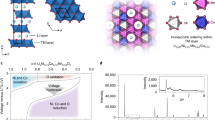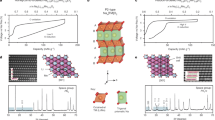Abstract
During the charging and discharging of lithium-ion-battery cathodes through the de- and reintercalation of lithium ions, electroneutrality is maintained by transition-metal redox chemistry, which limits the charge that can be stored. However, for some transition-metal oxides this limit can be broken and oxygen loss and/or oxygen redox reactions have been proposed to explain the phenomenon. We present operando mass spectrometry of 18O-labelled Li1.2[Ni0.132+Co0.133+Mn0.544+]O2, which demonstrates that oxygen is extracted from the lattice on charging a Li1.2[Ni0.132+Co0.133+Mn0.544+]O2 cathode, although we detected no O2 evolution. Combined soft X-ray absorption spectroscopy, resonant inelastic X-ray scattering spectroscopy, X-ray absorption near edge structure spectroscopy and Raman spectroscopy demonstrates that, in addition to oxygen loss, Li+ removal is charge compensated by the formation of localized electron holes on O atoms coordinated by Mn4+ and Li+ ions, which serve to promote the localization, and not the formation, of true O22− (peroxide, O–O ~1.45 Å) species. The quantity of charge compensated by oxygen removal and by the formation of electron holes on the O atoms is estimated, and for the case described here the latter dominates.
This is a preview of subscription content, access via your institution
Access options
Subscribe to this journal
Receive 12 print issues and online access
$259.00 per year
only $21.58 per issue
Buy this article
- Purchase on Springer Link
- Instant access to full article PDF
Prices may be subject to local taxes which are calculated during checkout






Similar content being viewed by others
References
Tarascon, J. M. & Armand, M. Issues and challenges facing rechargeable lithium batteries. Nature 414, 359–367 (2001).
Larcher, D. & Tarascon, J. M. Towards greener and more sustainable batteries for electrical energy storage. Nature Chem. 7, 19–29 (2015).
Goodenough, J. B. & Kim, Y. Challenges for rechargeable Li batteries. Chem. Mater. 22, 587–603 (2010).
Whittingham, M. S. Lithium batteries and cathode materials. Chem. Rev. 104, 4271–4301 (2004).
Croguennec, L. & Palacin, M. R. Recent achievements on inorganic electrode materials for lithium-ion batteries. J. Am. Chem. Soc. 137, 3140–3156 (2015).
Robert, R., Villevieille, C. & Novak, P. Enhancement of the high potential specific charge in layered electrode materials for lithium-ion batteries. J. Mater. Chem. A 2, 8589–8598 (2014).
Weaving, J. S. et al. Development of high energy density Li-ion batteries based on LiNi1–x–yCoxAlyO2 . J. Power Sources 97–98, 733–735 (2001).
Lu, Z. H., MacNeil, D. D. & Dahn, J. R. Layered cathode materials Li[NixLi(1/3–2x/3)Mn(2/3–x/3)]O2 for lithium-ion batteries. Electrochem. Solid State 4, A191–A194 (2001).
Lu, Z. H. & Dahn, J. R. Understanding the anomalous capacity of Li/Li[NixLi(1/3–2x/3)Mn(2/3–x/3)]O2 cells using in situ X-ray diffraction and electrochemical studies. J. Electrochem. Soc. 149, A815–A822 (2002).
Johnson, C. S. et al. The significance of the Li2MnO3 component in ‘composite’ xLi2MnO3·(1 – x)LiMn0.5Ni0.5O2 electrodes. Electrochem. Commun. 6, 1085–1091 (2004).
Thackeray, M. M. et al. Li2MnO3-stabilized LiMO2 (M = Mn, Ni, Co) electrodes for lithium-ion batteries. J. Mater. Chem. 17, 3112–3125 (2007).
Thackeray, M. M., Wolverton, C. & Isaacs, E. D. Electrical energy storage for transportation—approaching the limits of, and going beyond, lithium-ion batteries. Energ. Environ. Sci. 5, 7854–7863 (2012).
Koga, H. et al. Different oxygen redox participation for bulk and surface: a possible global explanation for the cycling mechanism of Li1.20Mn0.54Co0.13Ni0.13O2 . J. Power Sources 236, 250–258 (2013).
Koga, H. et al. Li1.20Mn0.54Co0.13Ni0.13O2 with different particle sizes as attractive positive electrode materials for lithium-ion batteries: insights into their structure. J. Phys. Chem. C 116, 13497–13506 (2012).
Yabuuchi, N., Yoshii, K., Myung, S. T., Nakai, I. & Komaba, S. Detailed studies of a high-capacity electrode material for rechargeable batteries, Li2MnO3–LiCo1/3Ni1/3Mn1/3O2 . J. Am. Chem. Soc. 133, 4404–4419 (2011).
Fong, R., Dahn, J. R. & Jones, C. H. W. Electrochemistry of pyrite-based cathodes for ambient-temperature lithium batteries. J. Electrochem. Soc. 136, 3206–3210 (1989).
Goodenough, J. B. & Kim, Y. Locating redox couples in the layered sulfides with application to Cu[Cr2]S4 . J. Solid State Chem. 182, 2904–2911 (2009).
Rouxel, J. Anion-cation redox competition and the formation of new compounds in highly covalent systems. Chem. Eur. J. 2, 1053–1059 (1996).
Tarascon, J. M. et al. In situ structural and electrochemical study of Ni1-xCoxO2 metastable oxides prepared by soft chemistry. J. Solid State Chem. 147, 410–420 (1999).
Saubanère, M., McCalla, E., Tarascon, J. M. & Doublet, M.-L. The intriguing question of anionic redox in high-energy density cathodes for Li-ion batteries. http://dx.doi.org/10.1039/C5EE03048J Environ. Energy Sci. (2016).
Koga, H. et al. Operando X-ray absorption study of the redox processes involved upon cycling of the Li-rich layered oxide Li1.20Mn0.54Co0.13Ni0.13O2 in Li ion batteries. J. Phys. Chem. C 118, 5700–5709 (2014).
Armstrong, A. R. et al. Demonstrating oxygen loss and associated structural reorganization in the lithium battery cathode Li[Ni0.2Li0.2Mn0.6]O2 . J. Am. Chem. Soc. 128, 8694–8698 (2006).
Castel, E., Berg, E. J., El Kazzi, M., Novak, P. & Villevieille, C. Differential electrochemical mass spectrometry study of the interface of Li2MnO3·(1–x)LiMO2 (M = Ni, Co, and Mn) material as a positive electrode in Li-ion batteries. Chem. Mater. 26, 5051–5057 (2014).
Jiang, M., Key, B., Meng, Y. S. & Grey, C. P. Electrochemical and structural study of the layered, ‘Li-excess’ lithium-ion battery electrode material Li[Li1/9Ni1/3Mn5/9]O2 . Chem. Mater. 21, 2733–2745 (2009).
Hong, J. et al. Critical role of oxygen evolved from layered Li-excess metal oxides in lithium rechargeable batteries. Chem. Mater. 24, 2692–2697 (2012).
Hy, S., Felix, F., Rick, J., Su, W. N. & Hwang, B. J. Direct in situ observation of Li2O evolution on Li-rich high-capacity cathode material, Li[NixLi(1–2x)/3Mn(2–x)/3]O2 (0 ≤ x ≤ 0.5). J. Am. Chem. Soc. 136, 999–1007 (2014).
Sathiya, M. et al. Reversible anionic redox chemistry in high-capacity layered-oxide electrodes. Nature Mater. 12, 827–835 (2013).
Sathiya, M. et al. High performance Li2Ru1–yMnyO3 (0.2 ≤ y ≤ 0.8) cathode materials for rechargeable lithium-ion batteries: their understanding. Chem. Mater. 25, 1121–1131 (2013).
Sathiya, M. et al. Origin of voltage decay in high-capacity layered oxide electrodes. Nature Mater. 14, 230–238 (2015).
McCalla, E. et al. Visualization of O–O peroxo-like dimers in high-capacity layered oxides for Li-ion batteries. Science 350, 1516–1521 (2015).
Goodenough, J. B. Perspective on engineering transition-metal oxides. Chem. Mater. 26, 820–829 (2014).
Genevois, C. et al. Insight into the atomic structure of cycled lithium-rich layered oxide Li1.20Mn0.54Co0.13Ni0.13O2 using HAADF STEM and electron nanodiffraction. J. Phys. Chem. C 119, 75–83 (2015).
Oishi, M. et al. Charge compensation mechanisms in Li1.16Ni0.15Co0.19Mn0.50O2 positive electrode material for Li-ion batteries analyzed by a combination of hard and soft X-ray absorption near edge structure. J. Power Sources 222, 45–51 (2013).
Freunberger, S. A. et al. Reactions in the rechargeable lithium–O2 battery with alkyl carbonate electrolytes. J. Am. Chem. Soc. 133, 8040–8047 (2011).
Aurbach, D., Daroux, M., Faguy, P. & Yeager, E. The electrochemistry of noble-metal electrodes in aprotic organic-solvents containing lithium-salts. J. Electroanal. Chem. 297, 225–244 (1991).
Aurbach, D., Gofer, Y. & Langzam, J. The correlation between surface-chemistry, surface-morphology, and cycling efficiency of lithium electrodes in a few polar aprotic systems. J. Electrochem. Soc. 136, 3198–3205 (1989).
Oishi, M. et al. Direct observation of reversible charge compensation by oxygen ion in Li-rich manganese layered oxide positive electrode material, Li1.16Ni0.15Co0.19Mn0.50O2 . J. Power Sources 276, 89–94 (2015).
Koga, H. et al. Reversible oxygen participation to the redox processes revealed for Li1.20Mn0.54Co0.13Ni0.13O2 . J. Electrochem. Soc. 160, A786–A792 (2013).
Ruther, R. E., Callender, A. F., Zhou, H., Martha, S. K. & Nanda, J. Raman microscopy of lithium-manganese-rich transition metal oxide cathodes. J. Electrochem. Soc. 162, A98–A102 (2015).
Amalraj, F. et al. Study of the lithium-rich integrated compound xLi2MnO3·(1–x)LiMO2 (x around 0.5; M = Mn, Ni, Co; 2:2:1) and its electrochemical activity as positive electrode in lithium cells. J. Electrochem. Soc. 160, A324–A337 (2013).
Hy, S., Su, W. N., Chen, J. M. & Hwang, B. J. Soft X-ray absorption spectroscopic and Raman studies on Li1.2Ni0.2Mn0.6O2 for lithium-ion batteries. J. Phys. Chem. C 116, 25242–25247 (2012).
Magnuson, M. et al. Self-doping processes between planes and chains in the metal-to-superconductor transition of YBa2Cu3O6.9 . Sci. Rep. 4, 7017 (2014).
Duda, L. C. et al. Bandlike and excitonic states of oxygen in CuGeO3: observation using polarized resonant soft-X-ray emission spectroscopy. Phys. Rev. B 61, 4186–4189 (2000).
Carniato, S. et al. A new method to derive electronegativity from resonant inelastic X-ray scattering. J. Chem. Phys. 137, 144303 (2012).
Hoang, K. Defect physics, delithiation mechanism, and electronic and ionic conduction in layered lithium manganese oxide cathode materials. Phys. Rev. Appl. 3, 024013 (2015).
Ito, A. et al. In situ X-ray absorption spectroscopic study of Li-rich layered cathode material Li[Ni0.17Li0.2Co0.07Mn0.56]O2 . J. Power Sources 196, 6828–6834 (2011).
Kim, J. M. & Chung, H. T. The first cycle characteristics of Li[Ni1/3Co1/3Mn1/3]O2 charged up to 4.7 V. Electrochim. Acta 49, 937–944 (2004).
Weill, F., Tran, N., Croguennec, L. & Delmas, C. Cation ordering in the layered Li1+x(Ni0.425Mn0.425Co0.15)1–xO2 materials (x = 0 and 0.12). J. Power Sources 172, 893–900 (2007).
Meng, Y. S. et al. Cation ordering in layered O3 Li[NixLi1/3–2x/3Mn2/3–x/3]O2 (0 ≤ x ≤ 1/2) compounds. Chem. Mater. 17, 2386–2394 (2005).
de Groot, F. M. F. et al. Oxygen 1s X-ray-absorption edges of transition-metal oxides. Phys. Rev. B 40, 5715–5723 (1989).
Acknowledgements
P.G.B. is indebted to the Engineering and Physical Sciences Research Council, including the SUPERGEN program, for financial support. The Advanced Light Source is supported by the Director, Office of Science, Office of Basic Energy Sciences, US Department of Energy, under Contract No. DE-AC02-05CH11231. The authors are also grateful to A. Dent and G. Cibin for contributing to the collection of hard XAS data and R. Smith for the collection of neutron diffraction data.
Author information
Authors and Affiliations
Contributions
K.L. and M.R.R. contributed to all aspects of the research. R.H. contributed to the synthesis and Raman spectroscopy. L.C.D., N.G., Y.-S.L., K.E. and J.G. contributed to the measurement and analysis of SXAS and RIXS spectroscopy. D.M.P. and A.V.C. contributed to analysis of hard XAS measurements. P.G.B., K.L., M.R.R. and L.C.D. interpreted the data. P.G.B. wrote the paper with contributions from K.L. and M.R.R. The project was supervised by P.G.B.
Corresponding author
Ethics declarations
Competing interests
The authors declare no competing financial interests.
Supplementary information
Supplementary information
Supplementary information (PDF 18930 kb)
Rights and permissions
About this article
Cite this article
Luo, K., Roberts, M., Hao, R. et al. Charge-compensation in 3d-transition-metal-oxide intercalation cathodes through the generation of localized electron holes on oxygen. Nature Chem 8, 684–691 (2016). https://doi.org/10.1038/nchem.2471
Received:
Accepted:
Published:
Issue Date:
DOI: https://doi.org/10.1038/nchem.2471
This article is cited by
-
Structurally robust lithium-rich layered oxides for high-energy and long-lasting cathodes
Nature Communications (2024)
-
Stabilizing lattice oxygen redox in layered sodium transition metal oxide through spin singlet state
Nature Communications (2023)
-
Delocalized electron holes on oxygen in a battery cathode
Nature Energy (2023)
-
Decoupling the roles of Ni and Co in anionic redox activity of Li-rich NMC cathodes
Nature Materials (2023)
-
Inhibiting collective cation migration in Li-rich cathode materials as a strategy to mitigate voltage hysteresis
Nature Materials (2023)



